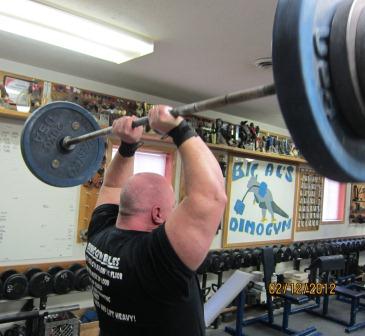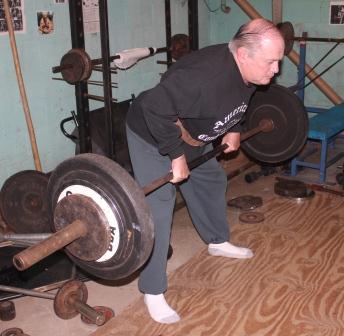French Press
by Al Myers

Chuck Cookson performing an ALL TIME best USAWA record of 207 pounds in the French Press at the 2012 Dino Gym Record Day. Take notice that Chuck has the perfect arm length to do this lift, and that his elbows are not even above his head when extended straight up!
This is an official lift of both the USAWA and the IAWA. Amazingly, the rules are the SAME as well as the lift is named the SAME. That is a rarity between USAWA and IAWA lifts!! However, that is about the ONLY THING I like about the French Press! I wish I knew more about how this lift came about and who was responsible for writing the original rules on it. They must have been written by a cruel person who likes to see lifters FAIL at performing a lift! The rules for this lift are written in a way that MOST lifters can’t even perform a French Press according to them. For a lift so simple in concept – these rules seem to me to be “over the top” for the French Press. I do know it has been around for quite a while as an all-round lift as it is represented in the old Missouri Valley Record List. The oldest record in the Mo-Valley list is held by Homer Lewellen of Columbia, Missouri who did a French Press of 185 pounds in 1962 in the 198 class. Other good marks in this record list were by Jim Charlton and Wayne Jackson. I just assume they were done with the same rules as we have today, as this lift was one of the original 110.
The USAWA Rules for the French Press
A25. French Press
The bar is brought from the platform to an overhead position by any method to assume the starting position of this lift. The lifter’s arms must be straight, the lifter standing, and the body upright before the start of the lift. Width of feet placement is optional. Once the bar is overhead and motionless, with the lifter’s arms straight, the lift begins at the lifter’s discretion. The hand spacing on the bar must not exceed 6 inches. The palms of the hands must be facing away from the lifter. The lifter will bend the arms and lower the bar until the bar touches the base of the neck at the junction of the shoulders without lowering the upper arms. The elbows must remain above the top of the head. Once the bar is on the base of the neck, an official will give the command to press. The elbows must not be lowered during any part of the press or it will be a disqualification. The legs must remain straight during the lift. There must not be any backbend, any bending of the knees, or movement of the feet during the lift. The heels and toes must not rise. Once the bar has been pressed, the arms straight and the bar motionless, an official will give a command to end the lift. The bar may be lowered by any method.
READ THE ABOVE RULE CAREFULLY as I know most USAWA lifters are not familiar with the legal nuances of this lift. As I’ve said – I don’t like the rules for the French Press. I have done French Presses in training in the past and the exercise I do (as well as most of my training partners) is NOTHING like the French Press described above! These rules are so restrictive that it prevents most lifters from even being capable of performing a legal French Press. Also, it is a terrible lift to judge – invaribly a lifters elbows drop to some degree and it makes for very subjective judging. If it is in a meet at least half of the lifters can’t even do a legal lift correctly, so the judging gets lax (and not in accordance with the written rules) just so lifters won’t “bomb out” on the lift. The French Press has been in one National Championship (2005), and if I have any say in it, that will be the last and only one that the French Press will be in.
However, like I said, the French Press is a great training lift for the shoulders and triceps if done differently. A wider grip, descending to only the back of the head, with a slight elbow drop allows for natural movement and normal shoulder rotation. The 6 inch grip width creates most of the problems, especially on a straight bar. Also, requiring the bar to touch the BASE of the neck creates issues if a lifters arm length is not of the correct proportions. I guess I just don’t understand why the rules for the French Press are written this way when the practicality of performing it in training is so much different?
However, at the Dino Gym Record Day I was proved wrong on many accounts when Dino Gym member Chuck Cookson performed a legal French Press of 207 pounds while maintaining PERFECT legal form. This record of Chuck’s is the top ALL TIME in the USAWA, besting Ernie Beaths mark of 200 pounds. I judged Chuck’s French Press and made sure it was done strictly in accordance with the rules. He has perfect body mechanics and limb lengths to do this lift with perfection. So – I guess I now feel the the French Press is a good lift because I know SOMEONE who can do it right! A Lot of the other USAWA lifts are also in the category of the French Press, ie Van Dam Lift, Mansfield, Zeigler, etc. I guess I feel if someone can do them correctly and excel in them, these lifts should be available to allow these few lifters to show their abilities in these difficult lifts at record days (But NOT in meets!!).

